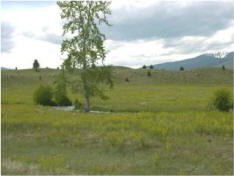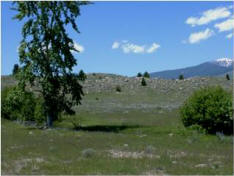|
Overview of Monitoring
Monitoring: An Early Warning System
The word "monitor" comes from the
root term meaning "to warn." Therefore, when
someone describes a
monitoring protocol they are simply referring to an
early warning system. We expect the vegetation around us to
change over time and across space. Land managers construct
and execute monitoring as an early-detection system to see if
they are headed in the right direction and enable them to take
appropriate actions and change
course if needed.
For example...
_sm.jpg) |
After a wildfire, a land manager of this sagebrush
steppe area in Southern Idaho may implement a monitoring program to
determine if and when the burned area recovers a plant community similar
to an unburned area. Likewise, specific criteria may be defined to
determine when a burned area has reach conditions adequate for a
sage-dependant species such as sage thrashers.
In this photo, a fire burned to a fence where grazing occurred thereby
reducing the fuel load and stopping the fire. |
| A rancher may implement a
monitoring protocol to determine if a new grazing system is affecting
establishment of sedges or willows along a stream to improve the
stability of stream banks. If the grazing system is not leading to the
desired condition, the grazing plan could be changed or the stream could
be fenced to remove grazing. In this photo, a
stream in Oregon showed improvement in 10 years after the season of
grazing was changed. The number of animals in the pasture was not
reduced, yet repeat photos showed the management change was effective. |
.jpg) |
.jpg) |
 |
A leafy spurge patch such as this could
be monitored to determine if the weed management plans are effective.
The Powell County Weed District in Montana implemented
a targeted grazing project near Deer Lodge to control leafy spurge. The
monitoring program revealed that the treatment was effective and
targeted grazing projects have been implemented for weed control across
Montana.
Click
here ¤¤ to Learn more about this project and
others conducted by the
Montana
Sheep Institute. |
 |
In summary, the
ability to accurately monitor natural resource conditions enables us to make
informed management decisions.
Monitoring: In Natural Resources
In natural resources, monitoring is the repeated
measurement and analysis of data to evaluate changes in the
characteristics of a given feature with the goal of meeting a
particular
management objective (See chapter 1 of
Measuring & Monitoring Plant Populations). Alternatively, we
may monitor the resource to determine if specific conditions
exist that might create opportunities for specific management
practices.
Clearly, if there is no ongoing management activity or no chance
to change existing management then there is no reason to waste
time monitoring vegetation. Focus time and money on places
where management activities can be changed in response to
monitoring. This is the essence of
adaptive management.
Scientific inquiry is a unique situation where
monitoring is aimed at answering a research question, not
directing management decisions. When conducting scientific
studies to understand the ecosystem, often called
natural history studies,
it is not known if the results will suggest appropriate
management strategies.
Ideally, management activities implemented in
response to monitoring should be flexible. Both the methods and
the objectives should be sufficiently flexible so that if new
conditions become apparent changes in the planned actions are
still possible. Also, the selected methodology, or simply what
we measure and monitor, may not be what was actually needed to
meet the management objectives. In this case, both the
objectives and methods should be carefully reviewed and revised
as necessary.
|